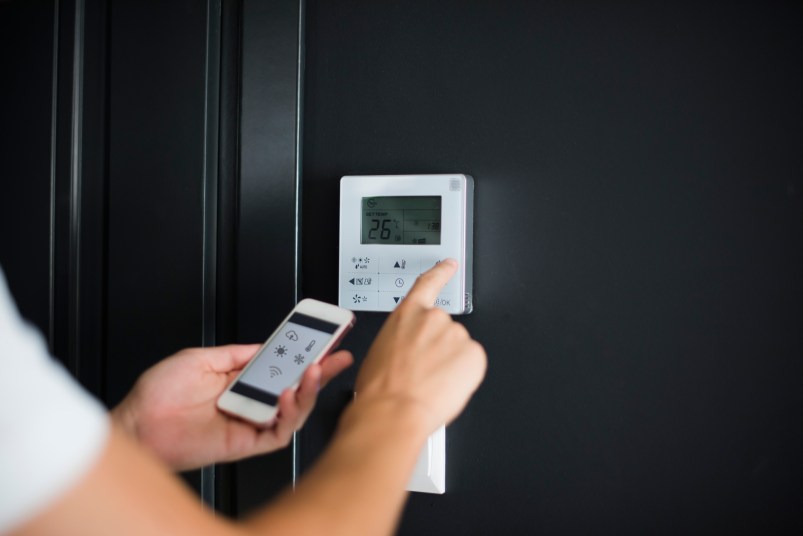8 Ways to Save Big on Utilities

As temperatures soar, so do home energy costs! Yet you can still keep your cool and save money with these simple pro tricks.
Slash costs with a smart thermostat.
“A common mistake? Blasting your air conditioner as soon as you get home. This makes it work harder, hiking up the bill. Instead try investing in a smart thermostat, which can cost around $170, but usually pays for itself in the first year.
Like with a regular thermostat, you set it to the ideal temperatures during specific time periods, but it monitors your energy use and behavior and automatically adjusts settings to make energy use as efficient as possible, saving you an average of 15 percent on cooling (nearly $145 annually) and 12 percent on heating in the winter.”
—Cisco DeVries, founder of OhmConnect.com, a clean energy company
Look into a new plan.
“Call your electricity provider and ask if they offer plans like ‘free’ hours — say, between 9 p.m. and 6 a.m., when any electricity used is free. When I called, they sent me a free energy savings kit including an advanced power strip, LED bulbs, and faucet aerators — an attachment that dilutes the volume of water you use with air so you use less, lowering your bill. Or switch to a new company, it can translate into 40 percent or more savings per year.”
—Chris Michaels, money-saving blogger for FrugalReality.com
Nix energy vampires.
“Just because you turned off a device, like a cable box, game console or electric toothbrush, doesn’t mean it stops using electricity — left on, they can account for 20 percent of your monthly bill! For example, a cable box uses around 35 watts, or $96 annually, but on standby mode, can add up to an extra $130 to $180 per year. To beat these energy vampires, use smart plugs or power strips (around $20). They detect when you’re no longer using a device and turn off the power supply, saving you around $432 per year.”
—Cisco DeVries
Swap in LED lights.
“Still working your way through a stockpile of old-school incandescent bulbs? You’re better off biting the bullet and buying new LEDs instead. Lighting can account for 12 percent of your home energy bill, and those old bulbs give off 90 percent of their energy as heat, which revs up your A/C. The good news: LED prices have decreased significantly in recent years, and in addition to lasting more than 20 times longer than incandescents, they use at least 80 percent less electricity. Just by making this simple switch, you can save $75 a year.”
— Mark Dawson, COO at electrical repair site MisterSparky.com
Switch filters for savings.
“Let’s face it, once the summer heat kicks in, most of us crank up our A/Cs until the fall. It might get the cool air you’re desiring, but if you don’t change your filters or clean your HVAC vents beforehand, they’ll be working extra hard and using more energy than they should — ultimately raising your energy bill by 15 percent! Don’t know how? It’s easy with a how-to online or on YouTube!” —Jonathan Desjardins, director at Desjardins Environment, an air ventilation cleaning service in Canada
Set your water heater to ‘vacation’ mode.
“Your home’s hot water heater accounts for around 25 percent of your total energy use. There are few reasons to keep it at a scalding level, and turning it down to 120 degrees Fahrenheit will slash your monthly bill. Or, since it just needs to be hot enough for running water to be comfortable, set your heater to ‘vacation mode.’ This takes it down to about 60°F when it’s not in use. And keep in mind that appliances that use hot water, like dishwashers, have their own heating element and will heat the water efficiently on their own.” —Ben Hood, CTO of energy intelligence service WattBuy.com
Run the fridge on this temperature for less.
“When it comes to saving money on the fridge, be sure to set it to no lower than 36°F, and the freezer to no lower than 0°F. Tip: It requires less energy to keep a full freezer cool than an empty one, so fill it up with inexpensive summertime treats like ice pops, or fill empty soda or water bottles with water and freeze them. They’ll take up space for free!” —Samantha Subar, of IberdrolaTexas.com, a renewable energy company that uses wind to power homes
Use the dishwasher.
“You may think you’re saving on energy costs by not running the dishwasher, but in households with two or more people, washing dishes by hand uses almost 10 times more hot water than dishwashers — and heating up all that water also adds to your bill! First, be sure to never pre-rinse dishes; just scrape them clean, and run the dishwasher only once it’s completely full. And wait to run it at night during non-peak hours when electricity costs are lower, usually after 9 p.m. or 10 p.m. Another smart kitchen hack: Try not to use the stovetop and the oven at the same time. This will keep the kitchen cooler, requiring less air conditioning, and save about 75 percent on energy.” —Dawn-Marie Joseph of EstatePlanningandPreservation.com
This article originally appeared in our print magazine.
















